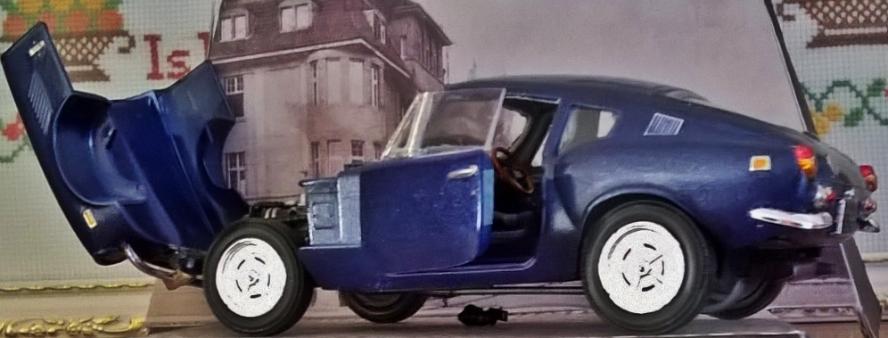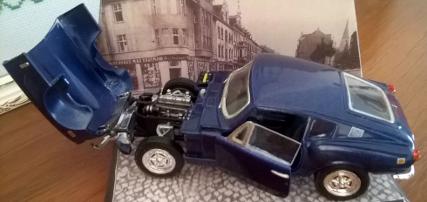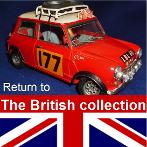
1969 Triumph GT6
Triumph's 1961 Spitfire was launched as a direct competitor to the Austin–Healey Sprite. This car quickly became popular offering open top driving fun at an affordable price. In 1963 Triumph wanted to build on this success by adding to it's range of sports cars. So, in 1963 Turin designer Giovanni Michelotti was sent a production Spitfire with the task of designing a hard top sports coupé body for the new Triumph Spitfire GT project. What he sent back a year later was a styling hit; but much too heavy for the 63bhp, 4–cylinder, Spitfire engine to handle so the project was shelved.
However Michelotti's fastback design remained in the Triumph racing boards mind so when they wanted a GT body for the racing Spitfire the Michelotti prototype was re-evaluated. It was found to give better aerodynamic performance than the standard Spitfire body shape so fibreglass copies of the body were grafted on to the race-modified Spitfires for competition in the 1964 season. It turned out to be a good decision as the racing Spitfire GT took 13th overall and a 1st in class at the 1965 Le Mans 24hrs (beating the MG Midgets).
Off the back of the racing programmes success Triumph decided to re-evaluate its shelved plans for a Spitfire GT. At this time the the Herald derived Triumph Vitesse was undergoing a mechanical facelift with the straight-6 1600cc engine being improved and enlarged to a 2–litre version. Suddenly new engine that could pull the heavier Michelotti GT body became available and the Spitfire GT project had the dust blown off it.
Getting the bigger engine into the 4cyl engine bay would take some juggling but some creative engineering saw the prop' shaft shortened, a new cooling system designed and the gearbox mountings further back. The one–piece front/bonnet of the car also had to be modified to clear the front of the engine rocker cover so a bulge appeared along its centre line.
While Triumph’s initial plan had been for a sporty Spitfire with a GT body what they ended up producing was a new car. The sporting development away from the Spitfire and the 2ltr Vitesse engine led Triumph to abandon the "Spitfire" prefix and launched the car as simply the GT6. This new model made its debut, at the 1966 Earl’s Court motor show and went into production soon reaching a build rate of between five and six hundred cars per month.
Interestingly Triumph marketed the GT6 from a point of view of the "race winning Le Mans Spitfires", capitalizing on the aesthetic similarities of the Spitfire and the GT6. This publicity was so convincing that there were people who erroneously believed the Le Mans Spitfires to actually be GT6s. On another front the GT6 was compared to the Jaguar 'E' type, long straight six hiding under the body, hatch back, little actual room inside but no shortage of refinement. The adage “poor man's 'E'-type” stuck.





Our model is built from the 1/25 scale Model King/Lindberg kit # 95777. Though the box (and moulded on lettering in the kit) say this is a Lindberg product it is Model King that have produced the kit as #358. Model King has no production facilities but instead is more like an agent that deals with companies, such as Lindberg and AMT, and arranges to produce these older kits for them. For those of us who wish to build such a model this system puts old kits back on the market at affordable prices rather than the, sometimes ridiculously, inflated prices seen in the collectors sites.
We have since been informed that the original release of this kit was by Pyro (kit # C503-200) and was taken over by Lindberg when Pyro went out of business in the late 1970s.
Most sprues are in white plastic with a chrome sprue, a clear sprue, and four very hard black vinyl tyres. No clear red sprue for the tail lights as those are moulded on the body. The model is designed so the hood and doors can be opened and as the body is in so many parts keeping everything lined up so these parts can open and close takes a lot of skill.
On the plus side the 6 cylinder single block engine is quite nice although most of the ancillary details are moulded in place they can be highlighted with paint and the major details are reasonable too. Remembering that this kit is 40+ year sold the engine as a unit is a good representation. There is a complete interior including moulded in seats and separate lap belts. Again the parts are quite simple but with careful painting do look nice. The suspension is sturdy courtesy of there being few parts in it. As for the body and bonnet/hood, as mentioned before, these are made from multiple parts and need care to align properly. As for the instructions these have arrows that are out of place as well as indistinct locations marked making this kit a product not for the beginner.
The down side is the kit is LHD so our model has been converted with a little scratch-building to RHD. Also the headlamp lenses have the lamp rims moulded in, but are far too small, so Rod made new rims for the kit lenses to fit into. Rod built most of this model straight from the box but the endless problems with the fit of parts and poor instructions led him to pass the kit to Ian in half built state. A fresh set of eyes new enthusiasm saw Ian pushed through to the finish of this model but this was not an easy job.
The model is painted
with Halfords acrylic car spry paints for the priming and body
colour. Humbrol enamels and acrylics from the Revell and Citadel
ranges of paints inks and washes for the details.
Another quirk of
this kit is the inclusion of additional hood scoops, side exhausts
(as on mid-60's Corvette), anti wheelie bar and others parts that
look very much out of place on this car. The decal sheet is equally
absurd with fictional numbers and sponsorship logos that are of
little use on the model or even in the spares book.
RETURN TO :-
